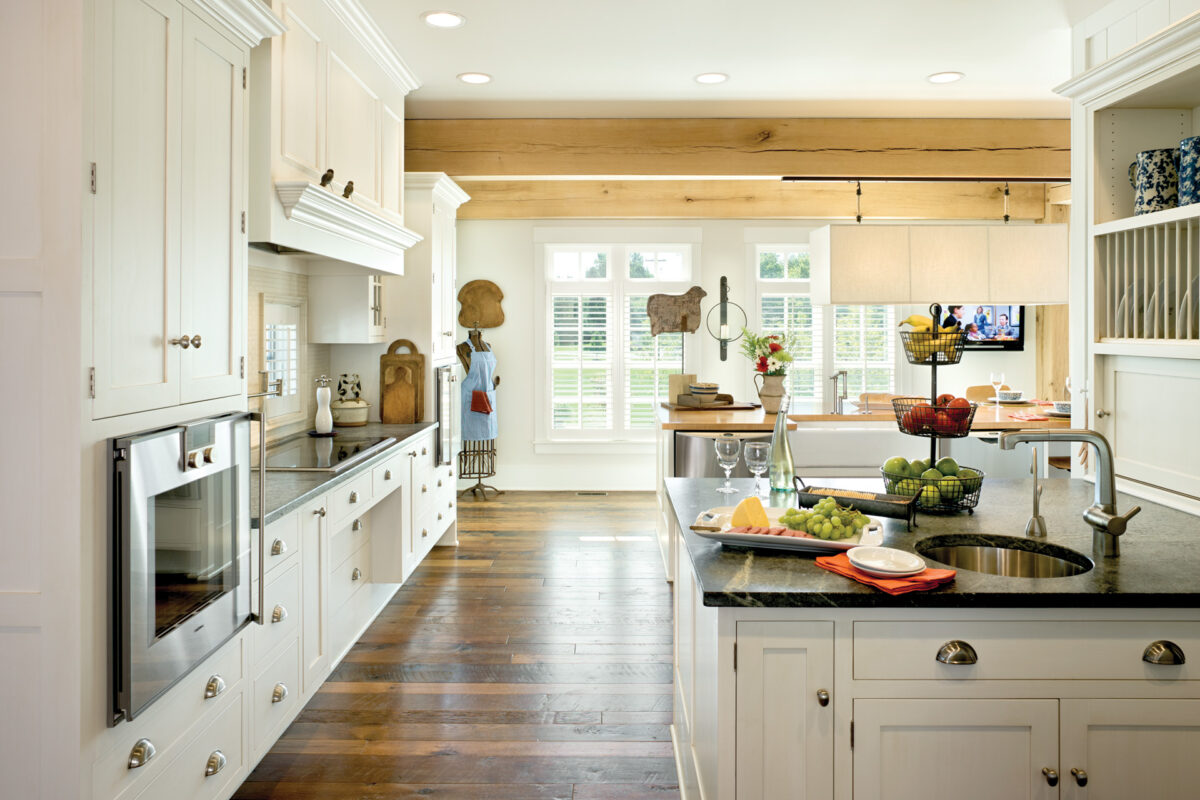Tips for making a log and timber home safe for aging parents without compromising beauty.
Creating a log and timber home design that will also accommodate an aging parent can be challenging but infinitely rewarding.
“Bringing a parent into your home has an impact on them and on you,” says Stephanie Hamrick, RN, MSN, PMHNP-BC, whose work as a psychiatric nurse practitioner includes many geriatric clients and their families. “Your parent is giving up a lifetime of independence, and you as their child, along with your spouse and other family members in the home, will be sacrificing your flexibility, but there are ways that just the arrangement of the living space can make this easier.”
Hamrick advises that if at all possible, one should create a distinct living space—whether attached or separate but adjacent to the main house—that is designed to address age-related conditions such as reduced mobility, limited range of reach, and decreased cognitive capacity.

Homeowner John Eslick planned his dream home with his mother’s future in mind.
“Dad had died a couple of years before my new house was to begin construction,” John said. “Mother and I agreed she’d have her own wing. The plan included extra-wide doorways throughout, accessible fixtures, grab bars and a no-threshold shower in her bathroom, additional incandescent lighting, and many other recommended design features. But when the day came for her to move, she was just not ready to give up her home.”
Hamrick says that reaction is not uncommon.“Even with all the amenities for safety and comfort, the sense of finality that comes with moving from their lifelong home may be too much,” Hamrick observes, pointing out that at any time during the process it may be healthy for everyone involved to seek counseling. “Sometimes when fears and expectations are discussed, the transition is much easier.”
In John’s case, a couple of years later his mother made her own decision to move in. However, she requested that the
separate pool house become her home, to which John and his spouse were happy to agree.
“Now, there is a beautiful and safe garden path between our doors,” John said. “Mother is almost 91, and I think that her maintaining her own home has kept her more active and healthy.”

Log home owner Denise Smith took a different approach when she and husband Peter made a move from Rhode Island to the Tennessee mountains. Denise’s mother, Rita, who is now 88, did not want to stay hundreds of miles behind, and Denise did not want that, either.
“It was my husband’s idea to build two log homes that were joined together,” Denise said. “We worked with our log home sales representative and manufacturer to design a two-in-one home for all of us.”
Rita’s one-story house is connected to Peter and Denise’s two-story home. They share an interior wall and a long, covered porch, but otherwise their spaces are very separate.
“My mother has the sewing room she’s always wanted,” Denise said. “And her home has a bedroom, bath, living room, kitchen/dining area and a utility room.”
Rita’s home also includes the garage portion of a full, walk-out basement, where Rita can park her car. The mother and daughter share a basement crafting-and-quilting room, and they both enjoy working outside in their log gardener’s cottage.
“Moving and including mother in our plans were both good decisions,” Denise said, adding, “We’ve never looked back.”
Hamrick says that including a parent in the decision-making process maintains a parent’s sense of belonging.
“Be sure your parent has a say in the design of their living area,” Hamrick suggests. “They can choose colors, fixtures, floor coverings and décor. If your parents are bringing items from their own home, make sure the plan accommodates the possessions that make them feel most comfortable. Of course, you should make the design decisions that ensure their safety.”
Some simple options that create a safer senior environment include non-skid flooring; adjustable, luminous light-switch controls; strobe-light or vibrator-assisted smoke and burglar alarms; programmable thermostats; and levered handles.
Hamrick noted that relinquishing personal meal-preparation responsibilities is among the most difficult changes for a senior.
“As long as your parents can safely prepare their own meals, allow them to,” Hamrick said. “They may not want to eat every meal with your family. Knowing you are welcome and feeling obligated are two different things.”
Some design modifications that work well for senior kitchens are cabinets with pull-out lower shelves and adjustable upper shelves; task lighting under counters; easy-to-grasp knobs and pulls; gas sensors; fire alarms; and counter spaces at a variety to heights in case a wheel chair becomes necessary.
“If your parent cannot prepare his or her own meals but is still able to eat alone, a small refrigerator with healthy snacks and favorite foods and a simple-to-use microwave can reinforce their feeling of autonomy,” Hamrick said.
Even if a parent is past the point of exploring the outdoors alone, windows and exterior doors can be selected that are both secure and stimulating. Through large windows and patio doors the changing of the seasons can be enjoyed. Bird or squirrel feeders bring nature close, and windchimes make melody of the breezes.
Hamrick also encourages families to acknowledge that their home may be their parent’s last.
“As hard as it is to admit or even imagine, there may come a day when your parent cannot attend his or her own needs,” Hamrick said. “As you design their living space, plan for the possibility of a walker, wheelchair or hospital bed. Know when to seek outside professional help that can preserve the quality of life for your parent as long as possible. There will be no greater sense of peace for you than knowing you did everything you could to make their final years comfortable and safe in a beautiful place where they were loved and wanted.”

